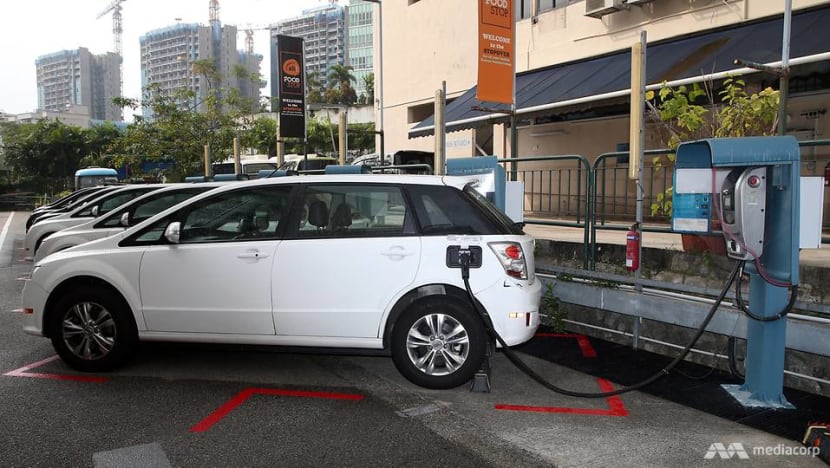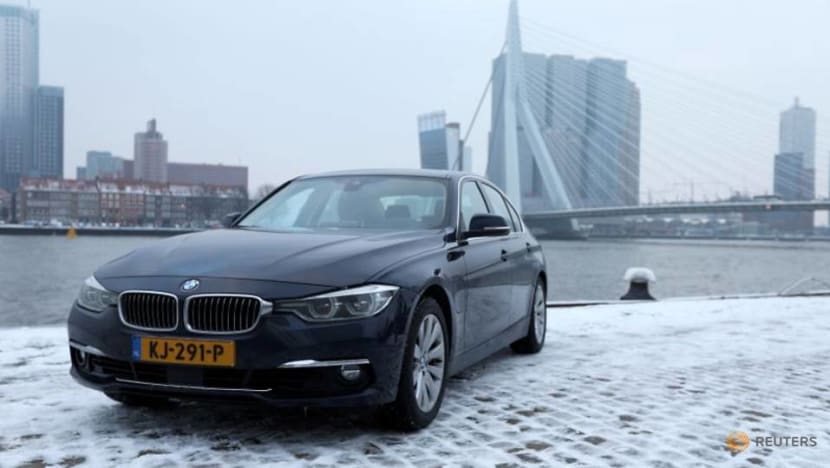Commentary: My journey to owning an electric vehicle has been a worthy ride
There are questions of cost, the still-modest charging infrastructure and the issue of battery life but overcoming these challenges are well worth it, says Sanjay Kuttan.

(Photo: TODAY/Ooi Boon Keong)
SINGAPORE: In the early 1990s during my postgraduate year at the National University of Singapore, a group of us tried to raise awareness of the ailing planet Earth. Despite being accused of “Greenpeace wannabes”, we organised a workshop.
It was a successful event but without the help of social media nor mainstream media, the energy around the effort fizzled out and the realities of living in Singapore began to crowd out our enthusiasm to do more to save the earth.
Fast forward to 2021 and my youthful ambitions have found a way to weave itself into my career. I joined an oil company, had a chance to work on electric vehicles at the Energy Market Authority and have become an ardent sustainability advocate since joining the Sustainable Energy Association of Singapore (SEAS).
My passion has been in transport and electric vehicles. So, when the COE of my beloved Honda Odyssey came up for renewal in 2017, my family considered the option of getting an electric vehicle.
READ: Commentary: Electric vehicles in Singapore – how much is just hype?
READ: The Big Read: After a decade of fits and starts, it’s all systems go for Singapore’s electric vehicle dream
Thankfully there were more car dealers in Singapore selling full battery electric (BEV) and plug-in hybrid electric (PHEV) vehicles. Finding the right model with the right price tag so that I could “walk-the-talk” as an advocate was easier.
However, in 2017 there were few charging stations. This was a legitimate concern to owning a BEV. I didn’t have my personal driveway for home charging, so I opted for a PHEV instead.
If I had bought it, it would have cost about S$174,500. But I opted to take a five-year lease at S$2,659 per month on my car to mitigate the risks around battery life since the battery warranty then was six years.
Leasing meant that the leasing company paid for everything except for petrol (about S$240 per month with 92RON), electrons (about S$50 per month), parking and ERP. Petrol spend comes down if electron spend goes up by S$3.45 per full charge and I can cover about 1,500 km per month.

Aside from spending so much less on petrol, it felt good that I was doing my bit for climate change. The ride was smooth and quiet too.
GAPS IN EV OWNERSHIP
The most expensive component of an electric vehicle is the battery. Even so, these costs have fallen by almost 90 per cent over the past decade and this trend is set to continue, falling another 60 per cent at least over the next five to eight years.
Today with experience, car and battery companies are willing to give eight to 10 years battery warranty. This duration is critical as it impacts the second-hand car market, and the type of car ownership.
I would have been more tempted to own the car if battery warranty was the same as the COE period. That would have reduced the risk of additional payments to replace spoilt batteries during the 10-year COE period.
READ: Commentary: Giving up petrol cars is a lot more difficult for parents
READ: Commentary: Will COVID-19 dim Singapore’s love affair with cars?
Unless of course, the Land Transport Authority decides to have five-year COEs for a special category of BEVs. This would facilitate a second hand-market thus increasing the penetration rate of BEVs in the market place, hence improving the utilisation of charging infrastructure and the return on investment (ROI) for infrastructure providers.
Most importantly this would accelerate the decarbonisation impact of the transport sector and therefore the return on the environment (ROE).
The total cost of ownership is lower not only in terms of “fuel” but because there are less than 20 moving parts in a BEV versus 2,000 in a normal car. So, maintenance costs are low.
The biggest challenge remains the convenience of charging lots. When I bought a BMW 225XE, Performance Motors had a collaboration with GreenLots (a station provider which Shell acquired) and the price of the car included free charging infrastructure.
But because I didn’t have a private driveway, I had to forfeit the offer. I did reach out to the Shell petrol station outside my house and offered my free charging unit to them.

Shell had bigger progressive plans – after acquiring GreenLots, they equipped their petrol stations with charging points islandwide.
That worked for me too since it’s a short drive away to the station. I can check the GreenLots App daily, and if the station is available, I drive over, leave the car there and walk home. An email alert tells me when charging is completed, usually in two hours.
WORKING AROUND THE GAPS
For most of us, opportunistic charging is probably all we need. You can drive for about 200km before you need to recharge.
There’s little need for range anxiety. Even with your average car, you don’t always drive with a full tank, but fill up as and when you need.
It is an easier decision today to go full electric than it was in 2017, even if one lives in a HDB or for parents who shuttle kids to tuition where the decision of owning a car is more around the seating capacity rather than its mode of propulsion.
Admittedly for electric cars, more planning is required but this is quickly changing as more stations are deployed by the SP Group.
READ: Commentary: Electric vehicles will take over Singapore. But here’s what must happen first
The government has announced to have 60,000 charging stations by 2030 and many of these will be in malls or parking areas accessible to public. Now Charge+ has also picked up the pace catching up with GreenLots and SP-managed stations with its recent MoU with OCBC Bank
Charging infrastructure providers have created apps which allow for easy location, access and payment.

The niggling problem usually is poor etiquette on the part of car owners (EV and non-EV) who occupy the parking lot but do not need to charge their vehicles. Some providers lock the wheels of errant drivers but they depend on others to inform the security or call the helpline.
To discourage overstayers at the stations, perhaps a two-tier payment system should be considered. For instance, driver is charged by the kwhr and when done, given a 15-minute grace before the driver is charged by the hour if it remains connected.
But this requires more provisions of parking lots for PHEVs and BEVs so cars can be repositioned. Innovative designs of charging infrastructure, like overhead cables on rollers drawing from one charging unit with smart management systems, can allow cost-effective multi-lot charging.
READ: Commentary: Where are all the electric vehicle charging points?
READ: Commentary: The great promise of self-driving cars that wasn't
THE ISSUE OF BATTERIES
The emergence of a circular economy and drive for recycling has put the spotlight on used car batteries from BEVs and PHEVs.
Most are powerful and have value in the “second life” battery market where they can be coupled to renewable energy systems, like solar, wind and even biodiesel generators.
With the increase in BEV and PHEV sales, more coordination is required to fully exploit this market and at some point, recycle key components.
The recently announced TES B facility in Tuas would be ready to recycle these batteries and extract the value to make recycling a sustainable business.
READ: Commentary: Taking Singapore’s green ambitions to new heights with a circular economy
Ultimately, car ownership is a personal decision. It can be a key part of the fight against climate change, where we all make adjustments that commensurate our ambition to be part of the solution.
I am still a “work-in-progress greenie”. But if I can make the finances work in the future, my next car will be a BEV.
Dr Sanjay C Kuttan is the chair of the sustainable infrastructure committee and council member of the Sustainable Energy Association of Singapore.














